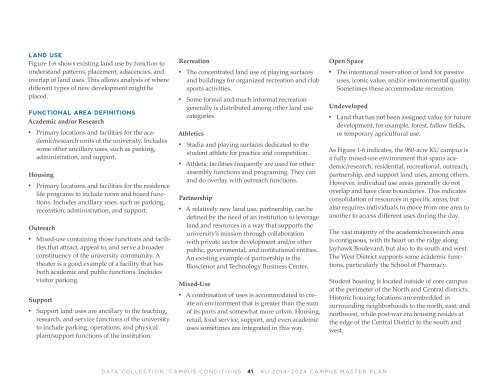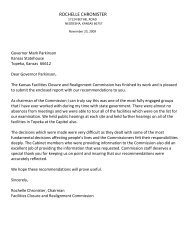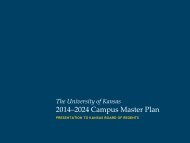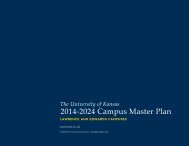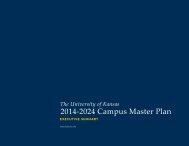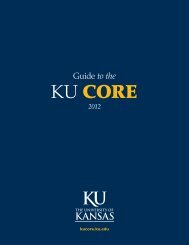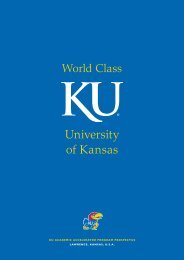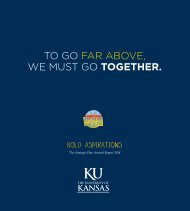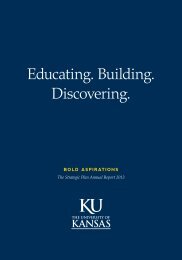KU_Chapter01_DataCollection_2014-06-10
KU_Chapter01_DataCollection_2014-06-10.pdf
KU_Chapter01_DataCollection_2014-06-10.pdf
- No tags were found...
Create successful ePaper yourself
Turn your PDF publications into a flip-book with our unique Google optimized e-Paper software.
LAND USE<br />
Figure 1-6 shows existing land use by function to<br />
understand patterns, placement, adjacencies, and<br />
overlap of land uses. This allows analysis of where<br />
different types of new development might be<br />
placed.<br />
FUNCTIONAL AREA DEFINITIONS<br />
Academic and/or Research<br />
••<br />
Primary locations and facilities for the academic/research<br />
units of the university. Includes<br />
some other ancillary uses, such as parking,<br />
administration, and support.<br />
Housing<br />
••<br />
Primary locations and facilities for the residence<br />
life programs to include room and board functions.<br />
Includes ancillary uses, such as parking,<br />
recreation, administration, and support.<br />
Outreach<br />
••<br />
Mixed-use containing those functions and facilities<br />
that attract, appeal to, and serve a broader<br />
constituency of the university community. A<br />
theater is a good example of a facility that has<br />
both academic and public functions. Includes<br />
visitor parking.<br />
Support<br />
••<br />
Support land uses are ancillary to the teaching,<br />
research, and service functions of the university<br />
to include parking, operations, and physical<br />
plant/support functions of the institution.<br />
Recreation<br />
••<br />
The concentrated land use of playing surfaces<br />
and buildings for organized recreation and club<br />
sports activities.<br />
••<br />
Some formal and much informal recreation<br />
generally is distributed among other land use<br />
categories.<br />
Athletics<br />
••<br />
Stadia and playing surfaces dedicated to the<br />
student athlete for practice and competition.<br />
••<br />
Athletic facilities frequently are used for other<br />
assembly functions and programing. They can<br />
and do overlay with outreach functions.<br />
Partnership<br />
••<br />
A relatively new land use, partnership, can be<br />
defined by the need of an institution to leverage<br />
land and resources in a way that supports the<br />
university’s mission through collaboration<br />
with private sector development and/or other<br />
public, governmental, and institutional entities.<br />
An existing example of partnership is the<br />
Bioscience and Technology Business Center.<br />
Mixed-Use<br />
••<br />
A combination of uses is accommodated to create<br />
an environment that is greater than the sum<br />
of its parts and somewhat more urban. Housing,<br />
retail, food service, support, and even academic<br />
uses sometimes are integrated in this way.<br />
Open Space<br />
••<br />
The intentional reservation of land for passive<br />
uses, iconic value, and/or environmental quality.<br />
Sometimes these accommodate recreation.<br />
Undeveloped<br />
••<br />
Land that has not been assigned value for future<br />
development, for example, forest, fallow fields,<br />
or temporary agricultural use.<br />
As Figure 1-6 indicates, the 960-acre <strong>KU</strong> campus is<br />
a fully mixed-use environment that spans academic/research,<br />
residential, recreational, outreach,<br />
partnership, and support land uses, among others.<br />
However, individual use areas generally do not<br />
overlap and have clear boundaries. This indicates<br />
consolidation of resources in specific areas, but<br />
also requires individuals to move from one area to<br />
another to access different uses during the day.<br />
The vast majority of the academic/reasearch area<br />
is contiguous, with its heart on the ridge along<br />
Jayhawk Boulevard, but also to its south and west.<br />
The West District supports some academic functions,<br />
particularly the School of Pharmacy.<br />
Student housing is located outside of core campus<br />
at the perimeter of the North and Central districts.<br />
Historic housing locations are embedded in<br />
surrounding neighborhoods to the north, east, and<br />
northwest, while post-war era housing resides at<br />
the edge of the Central District to the south and<br />
west.<br />
DATA COLLECTION: CAMPUS CONDITIONS<br />
41<br />
<strong>KU</strong> <strong>2014</strong>–2024 CAMPUS MASTER PLAN


